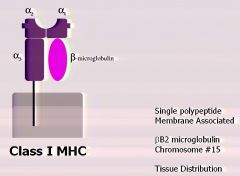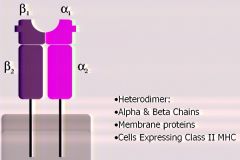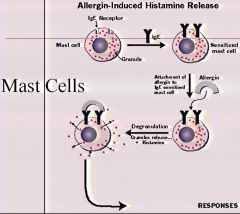![]()
![]()
![]()
Use LEFT and RIGHT arrow keys to navigate between flashcards;
Use UP and DOWN arrow keys to flip the card;
H to show hint;
A reads text to speech;
69 Cards in this Set
- Front
- Back
|
Function of Antigen Presenting Cells
|
deliver antigens to CD4+T Cells
- antigen fragments are displayed in a groove for antigen presenting molecules |
|
|
Antigen Presenting Cells
|
- proteins encoded by Major Hisocompatibility Complex (MHC)
- Dendritic cells, macrophages, B-cells - Dentritic cells = most efficient presenter of antigen during primary immune response - need cell surface class II MHC molecules, B7 and CD40 (Co-stimulatory molecules) |
|
|
Which antigen presenting cells is most effective during a primary immune response?
|
Dentritic cells
|
|
|
Target cells
|
cells that present antigens to CD8+ T cells
- use Class I MHC - target cells b/c response = death - all cells are potential targets b/c all cells express Class I MHC |
|
|
Which cells express Class I MHC?
|
all cells.
|
|
|
Name 3 Antigen Presenting Cells.
|
Dendritic Cells, Macrophages, B cells
|
|
|
Langerhans Cell
|
Immature dendritic cells in the skin
|
|
|
Dendritic cells
|
- antigen presenting cell: capture antigens and carry them to secondary lymphoid tissue
- express both CD4+ and chemokines |
|
|
Infection with HIV-1 is initiated by which 2 receptors?
|
CD4+ and Chemokine (CCR5 and/or CXCR4)
|
|
|
Immature Dendritic cells have high concentrations of ________ and low concentrations of ______ and _______.
|
high concentration: FcγR
low concentration: Class II MHC and costimulatory molecules |
|
|
Unlike immature dendritic cells, mature dendritic cells cannot _________ antigens.
|
endocytose. (cellular ingestion)
|
|
|
When are B cells effective as antigen presenting cells?
|
when there is limited antigens.
|
|
|
Why are dendritic cells the most effective antigen presenting cell?
|
they can capture antigens and transport them to the appropriate lymphoid tissue.
-in lymphoid tissue, activate T cells, which activate B cells. Produce Antibodies. - antibodies return to the site of infection to fight alongside macrophages |
|
|
What cells can be infected with HIV?
|
Dendritic cells and macrophages.
- they both have CD4 and chemokine (CCR5/CXCR4) receptors |
|
|
What is the structure of Class I MHC? Where are they expressed?
|

Expressed in all nucleated cells.
45 kd chain + β2-Microglobulin – conserved region (not polymorphic) |
|
|
What is the structure of Class II MHC? Where is it expressed?
|

Expressed in Professional Antigen Presenting Cells - Dendritic, Macrophages, B Cells.
It is a heterodimer with two 29kd chains and an invariant chain (Ii) |
|
|
What is the function of the Invariant chain (Ii)?
|

blocks binding to MHC when it's being transported in Endoplasmic reticulum. Also transports class II molecules thru the golgi, from where they are released in endosomes.
|
|
|
How does the Herpes Simplex Virus avoid detection?
|
- resides in neurons (very few Class I MHC)
- hinders TAP-mediated translocation of peptides - no peptides = no Class I MHC made - infection remains undetected |
|
|
How does the Epstein Barr Virus avoid detection?
|
- inhibits the activity of proteasomes = cannot hydolyze virus into fragments
- since no fragments, cannot fit in Class I MHC groove = safely sequestered in B Cell |
|
|
How does the Cytomegalovirus avoid detection?
|
hinders expression of Class I MHC complexes on cell surface
ie. redirects the newly synthesized class I MHC from ER back to cytoplasm and is degraded by proteasome |
|
|
Determinant Selection
|
MHC molecules present on cell do not bind to particular peptide.
peptide cannot be presented to T Cell |
|
|
cross-presentation
|
the ability of certain antigen-presenting cells to take up, process and present extracellular antigens with MHC class I molecules to CD8 T cells (cytotoxic T cells).
|
|
|
True/False: You cannot get an allergic response the first time you are exposed to something.
|

True. Need 7-10 days to produce IgE antibody. Both IgE need to be bound for allergic response
|
|
|
What are the two major classes of Antigen presenting molecules encoded by the MHC locus?
|
Class I MHC molecules & Class II MHC molecules.
|
|
|
Which cells express Class I MHC? Class II?
|
Class I MHC - All nucleated cells
Class II MHC - Only professional antigen presenting cells |
|
|
True/False: Antigen presenting cells express both class I and class II MHC molecules
|
True: Since all nucleated cells express MCH I molecules and you know that antigen presenting cells have class II, APC’s have both class I and II.
|
|
|
What is the HLA? Which chromosome is it located on?
|
The human MHC located on chromosome 6 is referred to as the
HLA: Human Leukocyte Antigens. |
|
|
Describe the subdivisions of Class I and II:
|
Class I MHC are encoded by three loci (A, B and C).
Class II are encoded by a “D” locus and it is subdivided into DP, DQ and DR. |
|
|
What is activation of various innate mechanisms for defense accompanied by?
|
Cytokine release.
|
|
|
What are cytokines?
|
Hormone-like proteins, that are secreted by many cell types, which regulate the intensity and duration of immune responses and are involved in cell-to-cell communication.
|
|
|
What happens in antigen presentation?
|
Antigen presenting cells deliver the antigen to CD4+T cells
|
|
|
What are antigen presenting molecules?
|
Proteins that are encoded by the major histocompatability complex (MHC).
|
|
|
What is the gene complex originally identified because of its role in graft rejection?
|
MHC
|
|
|
What do ALL antigen presenting cells require for their T cell stimulatory function?
|
Cell surface class II MHC molecules and other molecules, the so-called costimulatory molecules.
|
|
|
Why are all nucleated cells potential target cells?
|
Because all nucleated cells express class I MHC.
|
|
|
Where are immature dendritic cells found?
|
Virtually all lymphoid and non-lymphoid tissues.
Including the mucosal epithelium of the oral cavity, anus and vagina. |
|
|
How do immature dendritic cells function?
|
They function as sentinel cells in peripheral tissues where they capture antigens and carry them to secondary lymphoid tissues.
|
|
|
What do immature dendritic cells express high concentrations of?
|
FcγR
|
|
|
True/False: Dendritic cells express CD4.
|
True
|
|
|
What is CD4?
|
A molecule on T cells that determines the T cell lineage and function.
|
|
|
What is CD4 a receptor of?
|
HIV-1
|
|
|
How is infection of HIV-1 initiated?
|
By interaction of the viral protein with at least two receptors of the CD4 molecule and chemokine receptor CCR5 and/or CCR4.
|
|
|
IF a person has defective CCR5 receptors, what may happen?
|
The person may be relatively resistant to infection with HIV-1.
|
|
|
What is the difference between the location of occurrence for secondary and primary immune responses?
|
Primary occur in secondary lymphoid tissue and not at the site of infection.
Secondary occur at the site of infection |
|
|
Under what circumstance do CD4+T cells ONLY recognize antigenic peptides?
|
If they are displayed with Class II MHC molecules present on the surface of “professional” antigen presenting cells.
|
|
|
What blocks the binding of superfluous peptides that the MHC heterodimer might encounter in the endoplasmic reticulum?
|
The invariant chain (Ii) which transiently associates with class II MHC molecules in the endoplasmic reticulum
|
|
|
What are the three class II MHC molecules? How are they expressed?
|
HLA-DP, HLA-DQ and HLA-DR.
Expressed co-dominantly. |
|
|
How many different class II molecules can be expressed on the cell surface?
|
6
|
|
|
Under what circumstance do CD8+T cells recognize cells infected with a virus?
|
ONLY if it is attached to an antigenic peptide with a class I MHC molecule on the surface.
|
|
|
What is the B2-microglobulin?
|
A non-polymorphic molecule that does not have a transmembrane domain.
Encoded on chromosome 15. needed in order for MHC I to fold properly |
|
|
What are the three class I MHC molecules? How many can be expressed on each cell?
|
HLA-A, B and C
Co-dominant, so 6. |
|
|
Describe the process of exogenous antigen processing and presentation by class II MHC:
|
1. Microbes are endocytosed by antigen presenting cell.
2. Fusion of the endocytotic vesicle with lysosomes that release their contents into the endosome. 3. Second fusion in which newly formed vesicle fuses with an endosome that contains the class II MHC: creating a chimeric endosome. 4. Class II MHC/Li complex is exposed to lysosomal enzymes, the Ii chain is degraded. 5. Antigenic peptide binds the newly exposed groove of the class II MHC. 6. Chimeric endosome migrates to, and fuses with the cell membrane and the antigen peptide/class II MHC complex is displayed on the surface of the antigen presenting cell. 7. Complexes are recognized by T cell receptors present on CD4+T cells. 8. T cell is activated to secrete cytokines. |
|
|
Describe the process of endogenous antigen processing and presentation by Class I MHC:
|
1. Microorganisms in the cytoplasm, but not enclosed in a vacuole are broken down by a proteosome.
2. Cytosolic proteins are targeted for degradation after ubiquitin attaches to them. 3. The fragments generated by the proteosome bind to the Transporter of Antigen Processing (TAP) 4. The antigen is transported to the ER and contact the class I MHC molecules (45 kd and B-microglobulin). 5. Complexes are released from the golgi into vesicles that fuse with the cell membrane and display the antigen peptide/class I MHC complex. 6. This signals the immune system that this cell is infected. |
|
|
What is non-responsiveness?
|
Term used to describe a phenomenon in which the MHC molecules present on the cell do not bind to a particular peptide and so that peptide cannot be presented to the T cells.
|
|
|
What type of dendritic cells can endocytose antigen?
|
Immature, they lose ability as mature
|
|
|
Where are immature dendritic cells found?
|
everywhere but the brain
|
|
|
What 2 roles do mature dendritic play?
|
Display antigen, secrete cytokines
|
|
|
Why are macrophages more effective in 2nd response?
|
Infections mostly occur at site of infection where macrophages are and cant go back to lymph tissue.
|
|
|
What is role of transporter of antigen
processing (TAP) proteins? |
Transports proteoliticaly cleaved protein into ER
|
|
|
What type MHC requires TAP?
|
Class I MHC
|
|
|
What is the fate of invariant chain?
|
Degradation in 2nd fusion step by lysozyme
|
|
|
Where are immature dendritic cells found/not found?
|
everywhere but the brain
|
|
|
Immature dendritic cells express what receptor in high conc?
|
FCgR, low conc MHC II and B7
|
|
|
What type of dendritic cells can endocytose antigen
|
Immature, they lose ability as mature
|
|
|
What (2) roles do mature dendritic play?
|
Display antigen, secrete cytokines
|
|
|
Infection with HIV requires what on the cells surface?
|
CD4 and Chemokines (CCR5 and/or CXCR4)
|
|
|
Can dendritic cells or macrophages be infected with AIDS?
|
Yes, both have CD4 and chemokines
|
|
|
What chromosome has gene for B2 microglobulin?
|
15
|
|
|
What is role of TAP? What type MHC requires TAP?
|
Transports proteoliticaly cleaved protein into ER. MHC1
|

